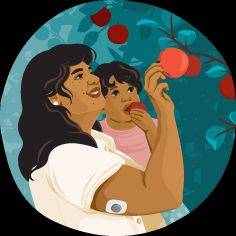Tatton-Brown-Rahman syndrome (TBRS) is a rare genetic condition that causes intellectual disability, joint hypermobility, and tall stature.
TBRS was first recognized in 2014. It’s estimated to affect less than 1 in 1 million people, although its exact prevalence isn’t known because many people are likely undiagnosed.
Researchers have found that people with TBRS have a mutation in their DNMT3A gene.
This article takes a closer look at TBRS, including symptoms, causes, treatment, and outlook.
TBRS is a relatively newly recognized genetic condition that causes:
TBRS is usually caused by a de novo (new) genetic variant, meaning that it doesn’t tend to have a family history. However, some clusters have been reported in families, such as in a
According to the Tatton-Brown-Rahman Syndrome Community website, about 450 people have been diagnosed to date. Many more people may be living with TBRS but have not received a diagnosis.
The characteristic signs and symptoms of TBRS vary between people. Some characteristics appear in essentially everybody, while others occur only in a minority of cases.
Many people share distinctive facial features. These features are most easily recognized during the
- a round face with coarse features
- thick, low-set eyebrows
- narrow opening of the eyes
- prominent upper front teeth
The following
| Symptom | Approximate frequency |
|---|---|
| intellectual disability, most often mild to moderate | 100% |
| joint hypermobility | 75% |
| tall stature | 70% |
| overweight | 65% |
| hypotonia (poor muscle tone) | 55% |
| behavior issues, most commonly autism spectrum disorder | 50% |
| 50% | |
| kyphoscoliosis (abnormal spinal curve) | 30% |
| seizures | 20% |
| undescended testicle | 20% of males |
| cardiovascular disease (heart disease) | 10% |
| ventriculomegaly (enlarged area in the brain) | less than 10% |
| Chiari malformation (abnormal development of the brain) | less than 10% |
| cancer, most commonly acute myeloid leukemia | 5% |
TBRS is a genetic condition caused by a mutation in the DNMT3A gene. It’s a dominant mutation, meaning only one of your two copies of this gene needs to have an associated mutation for you to develop TBRS.
This gene gives your body instructions on how to make an enzyme called DNA methyltransferase 3 alpha.
No particular risk factors for TBRS have been identified. Most reported cases haven’t been linked to a family history, but they have occasionally been linked to mutations passed through families.
A doctor may suspect TBRS if your child has characteristic signs and symptoms such as intellectual disability with large stature and facial deformities.
They can confirm the diagnosis by ordering a genetic test to look for an associated mutation in the DNMT3A gene. A genetic test is usually done in a laboratory using a small blood sample.
TBRS doesn’t have a cure. Treatment focuses on a person’s individual symptoms and improving quality of life.
The following table provides examples of how doctors may manage individual symptoms of TBRS.
| Sign/symptom | Treatment |
|---|---|
| Obesity | ? diet and exercise improvements ? working with a dietitian |
| Developmental delays | ? speech therapy ? physical therapy ? feeding therapy ? occupational therapy |
| Behavioral/ psychiatric diagnoses | ? talk therapies ? mental health services ? medications |
| Seizures | ? antiseizure medications |
| Joint hypermobility | ? diet and exercise improvements ? physical and occupational therapy |
| Kyphoscoliosis | ? physical therapy ? bracing ? surgery |
| Congenital heart defects | ? surgery ? medications |
| Undescended testicles | ? surgery |
| Leukemia | ? chemotherapy ? radiation therapy ? targeted therapy ? bone marrow transplant |
There’s a
Most people with TBRS seem to be in good overall health, and they may live a full or near full life span with minimal disruption to their quality of life.
The development of leukemia may be associated with a poorer outlook. However, leukemia is often treatable when caught in the early stages.
TBRS is a rare genetic disease that causes intellectual disability, distinctive facial features, and many associated health problems. People with this syndrome may develop a few or many of the potentially associated health conditions.
There’s no cure for TBRS, but receiving a proper diagnosis can allow doctors to predict what other health problems may develop in the future.
Your doctor can also recommend treatment options to manage particular symptoms.




